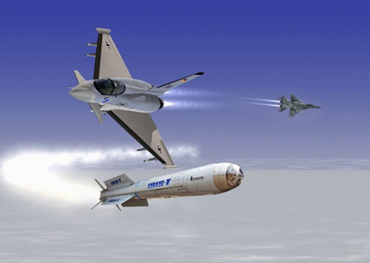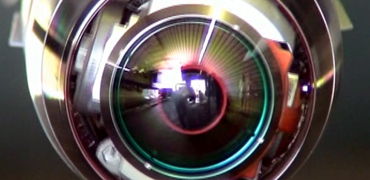It's 25 years since Norway purchased F-16 fighter jets.
With its young age the planes are as potent as they can be.
The IRIS-T missile is on its way as a replacement for the outdated Sidewinder
missile.
By Captain Thomas Bjørnholm / Flo press- and information
(text) / translated to english by SirViper
The Norwegian fighter aircraft will be greatly improved in the air-to-air role with this new IRIS-T missile. The new missile and the helmet-mounted-sight has a cost limit of about 1.4 billion norwegian kroner (~ $209 million). The upgrade will be a big improvement for the pilots and Norway's capability to maintain airspace supervision. The missile is scheduled for operational deployment in August 2006.
Two strong candidatesThe american made AIM-9X and the european made IRIS-T missiles have been the most interesting candidates to replace the Sidewinder. Major Roar Eggen, at the investment department in Forsvarets logistikkorganisasjon (Flo) , is in charge of the project to obtain the new air-air capacity for the norwegian fighter aircraft. - They are both strong candidates, and they have been thoroughly evaluated. The specifications for a new air-to-air missile were already composed in the mid 90s. This has been the foundation for the project and the tests that have been carried out. In the final evaluation where elements such as performance and cost were crucial, the decision landed on the IRIS-T, says Eggen.
TECHNOLOGY: Through the new helmet-mounted-sight the pilot gets target data, speed, range etc. The pilot can acquire the target by just looking at it. The photo shows the launch of the new IRIS-T missile that's heading towards the pilot's aim point.
Best used before
The existing Sidewinder missile has been in use on norwegian fighter aircraft
since its procurement in 1980. The missile has gone through numerous technological
upgrades, but now its life span is coming to an end. - A lot has happened
in missile technology the last twenty years, and the IRIS-T is the result
of this development, says Major Roar Eggen.
Norway participated in development
The development of the missile has been a comprehensive process. Norwegian
research communities and weapon industry have actively participated in the
development of the missile. The missile is a result of a multinational cooperation
between Norway, Sweden, Germany, Italy, Greece and Spain. The norwegian supplier
NAMMO has developed the propellant and parts of the engine on the IRIS-T.
MULTINATIONAL: Both the swedish Gripen and Eurofighter will be equipped with the IRIS-T missile.
Integrated with the F-16 systemWhen a new missile is going into service, you can't just strap it on the plane and start using it. - We have to go through an extensive certification- and configuration process before the new missile is ready for operational service. This has to be carried out in close cooperation with the manufacturer of the F-16 and the IRIS-T contractor, says Eggen. Both pilots and technical personnel must go through training. The first educational program will be carried out through the spring 2006. During the same period the aircraft will be prepared to start operating the missile. According to schedule the new missile will enter operational status from August 2006.
Air operational inspectorate (Luftoperativt inspektorat (LOI)) at Rygge is housing the military branch experts on the project. Personnel with fighter planes experience has contributed along the way, and soon the implementation stage will begin. Major Tord Aslaksen in the fighter aircraft branch is happy: - This is a major improvement to the weapon system F-16. IRIS-T is highly manoeuvrable, has longer range and can be launched earlier in combat. As a pilot my safety will be increased due to the fact that the launch perimeter will happen much sooner than today. In addition the missile has a very smart guidance system than very rarely will be foiled by flares. Along with the new missile we also get helmet-mounted-sights, which makes us capable of launching the missile from several aspects during combat. Together this system gives us a higher probability of survival in aerial combat.
Successful test launchThe IRIS-T missile has fully demonstrated its capability. In July this year Norway conducted, in cooperation with the EPAF nations, a successful test launch of the missile from a F-16. This was the first time a missile with a live warhead has been tested during the IRIS-T collaboration. The missile got a direct hit on a flying targeting drone after being launched from a norwegian F-16 MLU. The test launch was performed outside the west coast of Norway. A video of the test launch can be found here.
SPLASH: In June 12th this year a test launch was carried out from a norwegian F-16 MLU, just outside Lista. This was also the maiden live fire test for the new helmet-mounted-sighting system together with the IRIS-T missile. The photo above shows a segment of the new Pantera pod as the missile hits the target drone.
A great dayIn recent years the F-16 has been going through significant upgrades and stands out as a top fighter aircraft. It's rare that new weapon systems are put to use, especially new air-to-air weapons. The relative advantages the fighter aircraft has, with speed, height and range, will be further strengthened by the IRIS-T performance. Then perhaps it's not so weird that the pilots that get to operate this new technology are full of excitement. – For me, as a pilot, this is very exciting! It's been over ten years since we last got a new type of missile, says Aslaksen.
THE EYE : It's a 4th generation seeker head on the missile. It can move like an eye and lock on targets that emits heat.
IRIS-T FACTS:
Type: Air-to-air missile
Acronym: IRIS-T means Infra Red Imaging System – Tail/Thrust
vector controlled
The missile will be an integrated part of the weapon system for the F-16 MLU
(Midlife update) together with the helmet-mounted sighting system.
Is to replace todays heat-seaking short-range missiles (Sidewinder AIM-9L)
IRIS-T will be delivered between 2005 – 2009. Expected to be operational
on norwegian jets by autumn 2006.




